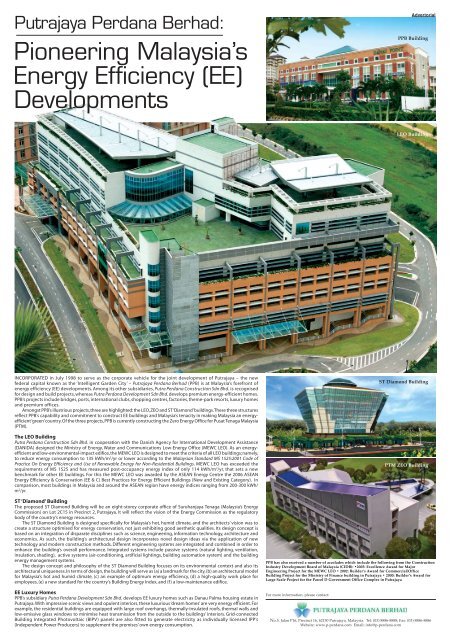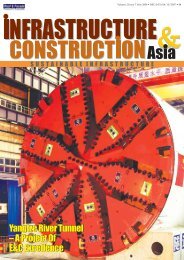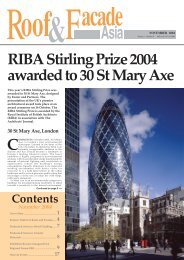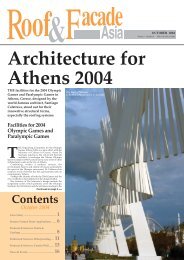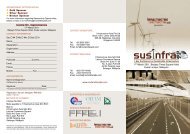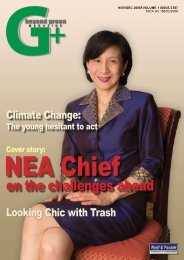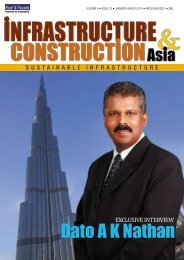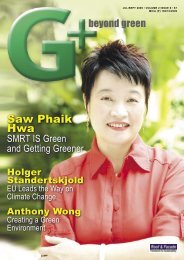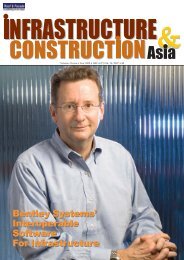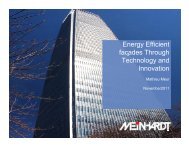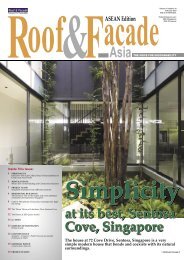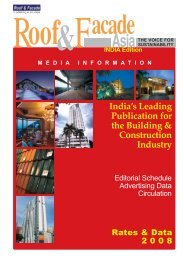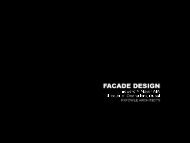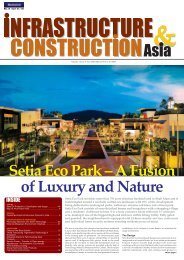ICA_Feb 07.pdf - Roof & Facade
ICA_Feb 07.pdf - Roof & Facade
ICA_Feb 07.pdf - Roof & Facade
You also want an ePaper? Increase the reach of your titles
YUMPU automatically turns print PDFs into web optimized ePapers that Google loves.
Putrajaya Perdana Berhad:<br />
Pioneering Malaysia’s<br />
Energy Efficiency (EE)<br />
Developments<br />
Advertorial<br />
PPB Building<br />
LEO Building<br />
INCORPORATED in July 1998 to serve as the corporate vehicle for the joint development of Putrajaya – the new<br />
federal capital known as the ‘Intelligent Garden City’ – Putrajaya Perdana Berhad (PPB) is at Malaysia’s forefront of<br />
energy efficiency (EE) developments. Among its other subsidiaries, Putra Perdana Construction Sdn Bhd. is recognised<br />
for design and build projects, whereas Putra Perdana Development Sdn Bhd. develops premium energy-efficient homes.<br />
PPB’s projects include bridges, ports, international clubs, shopping centres, factories, theme-park resorts, luxury homes<br />
and premium offices.<br />
Amongst PPB’s illustrious projects, three are highlighted: the LEO, ZEO and ST ‘Diamond’ buildings. These three structures<br />
reflect PPB’s capability and commitment to construct EE buildings and Malaysia’s tenacity in making Malaysia an energyefficient<br />
‘green’ country. Of the three projects, PPB is currently constructing the Zero Energy Office for Pusat Tenaga Malaysia<br />
(PTM).<br />
The LEO Building<br />
Putra Perdana Construction Sdn Bhd. in cooperation with the Danish Agency for International Development Assistance<br />
(DANIDA) designed the Ministry of Energy, Water and Communications Low-Energy Office (MEWC LEO). As an energyefficient<br />
and low-environmental-impact edifice, the MEWC LEO is designed to meet the criteria of all LEO buildings; namely,<br />
to reduce energy consumption to 135 kWh/m 2 /yr or lower according to the Malaysian Standard MS 1525:2001 Code of<br />
Practice On Energy Efficiency and Use of Renewable Energy for Non-Residential Buildings. MEWC LEO has exceeded the<br />
requirements of MS 1525 and has measured post-occupancy energy index of only 114 kWh/m 2 /yr, that sets a new<br />
benchmark for other EE buildings. For this the MEWC LEO was awarded by the ASEAN Energy Centre the 2006 ASEAN<br />
Energy Efficiency & Conservation (EE & C) Best Practices for Energy Efficient Buildings (New and Existing Category). In<br />
comparison, most buildings in Malaysia and around the ASEAN region have energy indices ranging from 200-300 kWh/<br />
m 2 /yr.<br />
ST ‘Diamond’ Building<br />
The proposed ST Diamond Building will be an eight-storey corporate office of Suruhanjaya Tenaga (Malaysia’s Energy<br />
Commission) on Lot 2C15 in Precinct 2, Putrajaya. It will reflect the vision of the Energy Commission as the regulatory<br />
body of the country’s energy resources.<br />
The ST Diamond Building is designed specifically for Malaysia’s hot, humid climate, and the architects’ vision was to<br />
create a structure optimised for energy conservation, not just exhibiting good aesthetic qualities. Its design concept is<br />
based on an integration of disparate disciplines such as science, engineering, information technology, architecture and<br />
economics. As such, the building’s architectural design incorporates novel design ideas via the application of new<br />
technology and modern construction methods. Different engineering systems are integrated and combined in order to<br />
enhance the building’s overall performance. Integrated systems include passive systems (natural lighting, ventilation,<br />
insulation, shading), active systems (air-conditioning, artificial lightings, building automation system) and the building<br />
energy management systems.<br />
The design concept and philosophy of the ST Diamond Building focuses on its environmental context and also its<br />
architectural uniqueness. In terms of design, the building will serve as (a) a landmark for the city, (b) an architectural model<br />
for Malaysia’s hot and humid climate, (c) an example of optimum energy efficiency, (d) a high-quality work place for<br />
employees, (e) a new standard for the country’s Building Energy Index, and (f) a low-maintenance edifice.<br />
EE Luxury Homes<br />
PPB’s subsidiary Putra Perdana Development Sdn Bhd. develops EE luxury homes such as Danau Palma housing estate in<br />
Putrajaya. With impressive scenic views and opulent interiors, these luxurious ‘dream homes’ are very energy efficient. For<br />
example, the residential buildings are equipped with large roof overhangs, thermally-insulated roofs, thermal walls and<br />
low-emissive glass windows to minimise heat transmission from the outside to the buildings’ interiors. Grid-connected<br />
Building Integrated Photovoltaic (BIPV) panels are also fitted to generate electricity as individually licensed IPP’s<br />
(Independent Power Producers) to supplement the premises’ own energy consumption.<br />
PPB has also received a number of accolades which include the following from the Construction<br />
Industry Development Board of Malaysia (CIDB): •2003: Excellence Award for Major<br />
Engineering Project for the MEWC LEO • 2002: Builder’s Award for Commercial/Office<br />
Building Project for the Ministry of Finance building in Putrajaya • 2000: Builder’s Award for<br />
Large Scale Project for the Parcel D Government Office Complex in Putrajaya<br />
For more information, please contact:<br />
ST Diamond Building<br />
PTM ZEO Building<br />
No.5, Jalan P16, Precinct 16, 62150 Putrajaya, Malaysia. Tel: (03) 8886-8888; Fax: (03) 8886-8886<br />
Website: www.p-perdana.com Email: info@p-perdana.com


